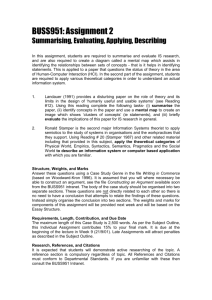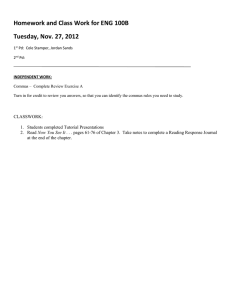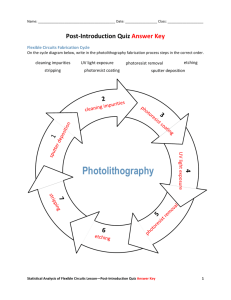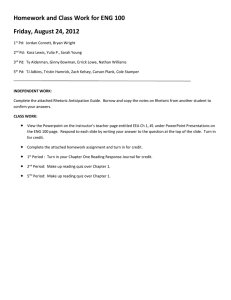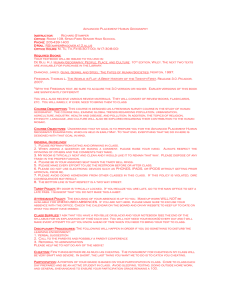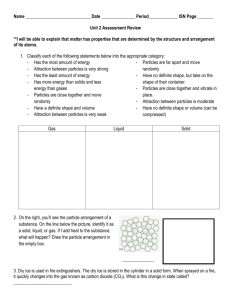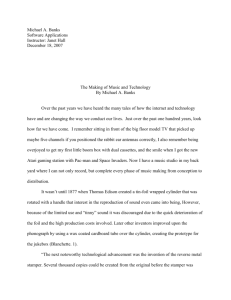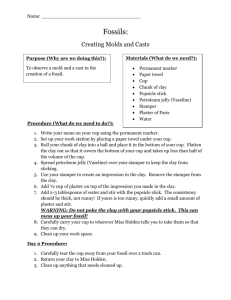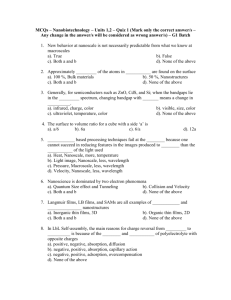Precision manufacture of
advertisement
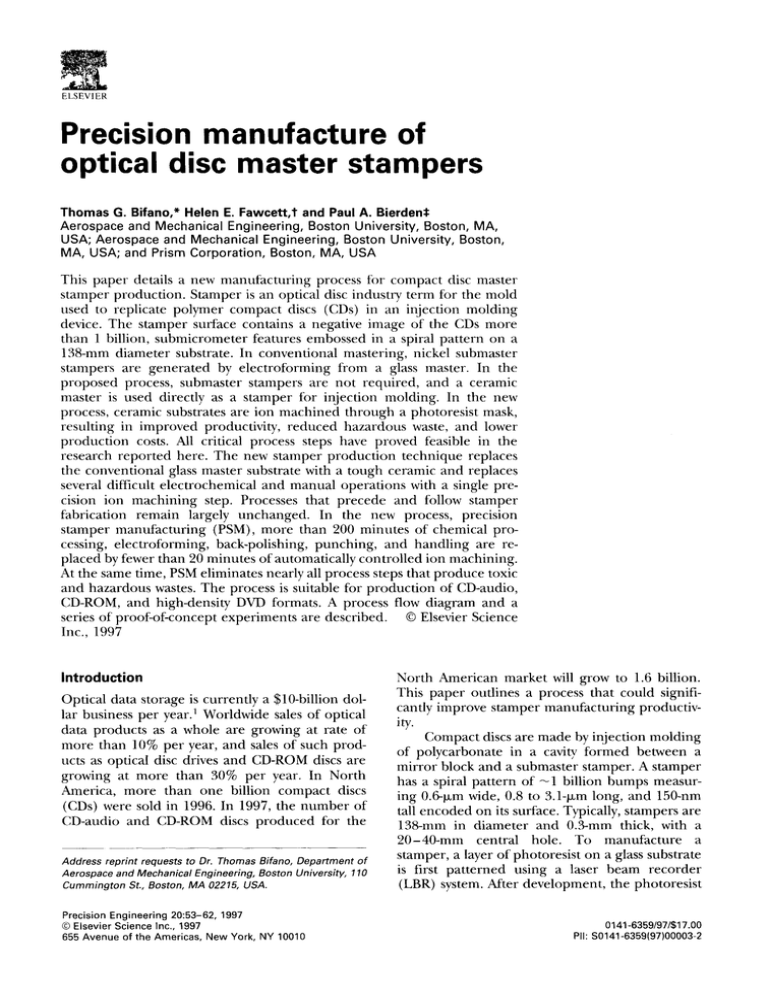
ELSEVIER Precision manufacture of optical disc master stampers Thomas G. Bifano,* Helen E. Fawcett,t and Paul A. Bierden* Aerospace and Mechanical Engineering, Boston University, Boston, MA, USA; Aerospace and Mechanical Engineering, Boston University, Boston, MA, USA; and Prism Corporation, Boston, MA, USA This paper details a new manufacturing process R)r compact disc master stamper production. Stamper is an optical disc industry term for the mold used to replicate polymer compact discs (CDs) in an injection molding device. The stamper surface contains a negative image of the CDs more than 1 billion, submicrometer features embossed in a spiral pattern on a 138-ram diameter substrate. In conventional mastering, nickel submaster stampers are generated by electroforming from a glass master. In the proposed process, submaster stampers are not required, and a ceramic master is used directly as a stamper for injection molding. In the new process, ceramic substrates are ion machined through a photoresist mask, resulting in improved productivity, reduced hazardous waste, and lower production costs. All critical process steps have proved feasible in the research reported here. The new stamper production technique replaces the conventional glass master substrate with a tough ceramic and replaces several difficult electrochemical and manual operations with a single precision ion machining step. Processes that precede and follow stamper fabrication remain largely unchanged. In the new process, precision stamper manufacturing (PSM), more than 200 minutes of chemical processing, electroforming, back-polishing, punching, and handling are replaced by fewer than 20 minutes of automatically controlled ion machining. At the same time, PSM eliminates nearly all process steps that produce toxic and hazardous wastes. The process is suitable for production of CD-audio, CD-ROM, and high-density DVD formats. A process flow diagram and a series of proof-of-concept experiments are described. © Elsevier Science Inc., 1997 Introduction Optical data storage is currently a $10-billion dollar business per year) Worldwide sales of optical data products as a whole are growing at rate of more than 10% per year, and sales of such products as optical disc drives and CD-ROM discs are growing at more than 30% per year. In North America, more than one billion compact discs (CDs) were sold in 1996. In 1997, the n u m b e r of CD-audio and CD-ROM discs produced for the Address reprint requests to Dr Thomas Bifano, Department of Aerospace and Mechanical Engineering, Boston University, 110 Cummington St., Boston, MA 02215, USA Precision Engineering 20:53-62, 1997 © Elsevier Science Inc, 1997 655 Avenue of the Americas, New York, NY 10010 North American market will grow to 1.6 billion. This paper outlines a process that could significantly improve stamper manufacturing productivity. Compact discs are made by injection molding of polycarbonate in a cavity formed between a mirror block and a submaster stamper. A stamper has a spiral pattern of - 1 billion bumps measuring 0.6-1xm wide, 0.8 to 3.1-1xm long, and 150-nm tall e n c o d e d on its surface. Typically, stampers are 138-ram in diameter and 0.3-mm thick, with a 20-40-mm central hole. To manufacture a stamper, a layer of photoresist on a glass substrate is first patterned using a laser beam recorder (LBR) system. After development, the photoresist 0141-6359/97/$17.00 PII: S0141-6359(97)00003 2 Bifano et al.: Optical disc master stampers layer contains a unique spiral pattern of elongated holes corresponding to the digitally e n c o d e d data that is to be reproduced. A thick electroformed layer of nickel is grown on top of the photoresist to form a stamper. After peeling it from the glass and photoresist, this nickel stamper can be used in an injection molding system to replicate polymer discs. The n u m b e r of discs m o l d e d with each stamper is usually d e t e r m i n e d by the customer's order for replicas and not by the m a x i m u m possible stamper life. The average order is 3000 replicas/stamper. In 1997, the North American market will require more than 500,000 stampers, with an average sales price of $400-$800 per stamper. Presently, a stand-alone mastering process line costs more than $2.5 million, and has a peak yield of approximately 15 stampers per day. Although the CD market is flourishing, CD manufacturing processes have seen little improvem e n t since the product was first introduced more than a decade ago. Today, the industry faces intense d e m a n d for increased production speed, reduced toxic waste generation, and increased yield. The new process described in this paper replaces several difficult and failure p r o n e process steps with a radically improved, simpler alternative. Specifically, the process of electroforming to generate a submaster stamper and the subsequent manual processes of peeling, varnishing, back-polishing, and p u n c h i n g are replaced by a single, automated process: neutral ion machining of CD features directly onto a ceramic master stamper. Ion machining, an emerging precision manufacturing technology, is inherently suited to nanometer-scale material removal. In the process described here, ion machining of the ceramic master is p e r f o r m e d through a patterned photoresist mask. By eliminating the processes responsible for most of the toxic waste byproducts (e.g., heavy metals, acids, and solvents) generated during stamper manufacturing, the new process is cleaner. Also, the processing time for fabricating a master stamper is cut in half. As a final benefit, the process eliminates the manual handling required in conventional stamper manufacturing. Substantial increases in the process yield are expected. By industry standards these new steps represent a revolutionary change in optical disc mastering technology. Conventional stamper manufacturing Major steps in the conventional process for fabricating optical disc stampers are illustrated in Figure 1. 2 A flat, polished glass substrate disk is cleaned and then coated with a thin layer of positive-tone 54 Time (hrs) Input: Flat, smooth soda-lime glass disk -- (~00 Clean disk, coat with I x ~ t i v e * t o n e phototasist, bake. 0:20 m Original disk cross section 0:.40 L Seleetivdy expose photcc~ist using switched, focused argon laser 1:20 1:40 Devetop photoresist 2:00 2:20 Me~izv and electrv(orm with nickel 2:40 3:00 Peelnkke.~sub-toss.stamper[ 3:20 from g l ~ disk. Apply p~tective coating, cure,cool. Polish back of sub-master 3:40 -4:(X) ~ ~ ~ .......... "~D::" Punch I.D.and O.D. Mal)llal ~P~I coad~g and cleanforu~ in ; _.~njec~on moldingmachine 4:20 .... ........................... ,,-"~:" Output: Nlek~ ~amper J~Itablefor ll~eetlon molding Figure 1 Conventional stamper manufacturing process steps photoresist. Next begins the recording process. A focused laser beam traces a spiral path on the disk surface. A control c o m p u t e r containing the digital information to be recorded on the disk switches the beam on and off according to a streaming binary signal. After recording, the photoresist is developed, leaving elongated pits where it was exposed to laser irradiation. The patterned photoresist is coated with a thin layer of nickel or silver by sputtering or chemical immersion to make the surface conductive for subsequent electroforming. In electroforming, a thick film of nickel is grown on the substrate. This nickel submaster stamper is then peeled away from the substrate and cleaned. A protective varnish coating is temporarily deposited onto the stamper surface and cured. The stamper back side is polished, and the inner and outer diameters are p u n c h e d on a press. The varnish is then removed from the stamper, which is now ready to be used in an injection m o l d i n g machine to generate thousands of polycarbonate CD replicas. The total manufacturing time for a single CD submaster stamper is a little m o r e than 4 hours. The overall process yield for master stamper p r o d u c t i o n is typically about 80%. Toxic waste byproducts of metalization and JANUARY 1997 VOL 20 NO 1 Bifano et al.: Optical disc master stampers electroforming include, for each stamper generated, m o r e than 3 liters of treatable chemical waste containing about 250 ml each of silane, palladium chloride, tannine, and stannous chloride in aqueous solutions. Chemical wastes that must be contained and treated as hazardous include a n o t h e r 3 liters of aqueous solutions containing about 250 ml each of nickel and silver nitrate. Exhaust gases from metalization and electroforming also contain hazardous vapors that require treatment, including methyl-ether-ketone (MEK), toluol, ammonia, nickel, and boric acid. In processes following electroforming, further solvent wastes are generated. In addition to waste generation and yield problems, the electroforming process f u n d a m e n tally limits the speed at which CD stampers can be fabricated. Growth of the nickel, for example, is already p e r f o r m e d at the m a x i m u m rate that will allow acceptable metallurgical properties in the stamper. In the first few minutes of electroforming, all of the detail a n d fine structure e n c o d e d on the glass and photoresist master disc are replicated in the nickel. Subsequent growth increases stamper thickness to allow sufficient structural rigidity for stamper use in a mold. Slow procedures and sensitive processing chemistry make electroforming a troublesome, t h o u g h universally used, step in CD stamper manufacturing. Batch electroforming of multiple stampers has been used in the past to increase overall manufacturing speed. However, recent industry d e m a n d for t u r n a r o u n d of individual stamper orders in 24 hours or less makes in-line processing a m o r e competitive strategy. Most new CD stamper fabrication systems use in-line manufacturing, for which recording and electroforming are the principal bottlenecks. In recent years, double and triple speed recording systems have been developed, but no parallel productivity increases have been m a d e in electroforming. A revision of the CD manufacturing process that replaces the latter half of the processing steps with direct ion m a c h i n i n g of the master disc could dramatically improve the process economy, speed, and yield while reducing its environmental impact. An alternative technical approach to stamper fabrication A new manufacturing process for stamper fabrication that uses ion machining to etch CD features directly onto a stamper surface is described below. The new process, precision stamper (PSM), calls for two major changes in the manufacturing process for stampers: PRECISION ENGINEERING T i ; c (hrs) ~ Input: Flat, smooth ceramic disk - - Original disk cross section ~ Clean disk, coat with neSat~ve-tone photoresist, bake. 0:20 Selectively expose photoresist using switched, focused argon laser I:2(I I Develop pl~)resist 2:(X} ..~.=......~.._ --Ton etch through photoresist m~k. _Remove photor~st, clean Output: Ceramic ma~ter stamper sldtable for injeeUon molding Figure 2 Schematic of the new process for precision stamper manufacturing (PSM) 1. replacing the glass master disk substrate with a tough ceramic, which is used as the injection molding stamper; and 2. replacing metalization, electroforming, peeling, protecting, polishing, and p u n c h i n g operations with a single ion m a c h i n i n g step on the ceramic substrate t h r o u g h a photoresist mask. All other processes, including cleaning the master disc, spinning on a photoresist layer, laser recording, and photoresist d e v e l o p m e n t remain largely unchanged. In PSM, production of a submaster nickel stamper is no longer necessary. The ion-machined ceramic master stamper is used directly for polymer injection molding. The proposed manufacturing cycle is illustrated schematically in Figure 2. Note that the processing time is r e d u c e d by a factor of 2 from the conventional manufacturing process detailed in Figure I. More than 200 minutes of the present manufacturing processes are replaced by 10-20 minutes of ionmachining processes (inclusive of time for part handling, transfer t h r o u g h a vacuum interlock, and cleaning). Capital e q u i p m e n t costs and direct manufacturing costs for PSM are similar to those required for the present process. An additional benefit of the p r o p o s e d process in comparison with the conventional process is that it eliminates many of the process steps that produce toxic and hazardous wastes. Ion m a c h i n i n g as a precision material removal process has been refined for use in subaperture shaping of glass and ceramic substrates, and for such high-technology applications as fabrica- 55 Bifano et al.: Optical disc master stampers Table 1 Prospective stamper substrate materials and relevant properties Substrate Thermal shock Knoop hardness, Fracture toughness, resistance, Thermal conductiv(kg/mm 2) (MPa m 1/2) (W/m) ity, (W/m K) Nickel 100 A1203 2100 SiC 2500 Glassy carbon ® 500 Corning 9647® 450 - 100 4 3 2 1.3 tion of individual three-dimensional (3-D) microstructures, sharpening of scanning probe tips, and imprinting patterns on carbides. ~-6 The process, which is distinct from the more well-known process of reactive ion etching, employs a plasma-generating source that ionizes argon gas in an evacuated chamber. While still in the source, ionized atoms (usually argon, but helium and other inert gasses have also been used) are accelerated by a DC electric field through a grid-shaped aperture. As they leave the source at high velocity, the collimated beam of chemically inert ions is electrically neutralized by an oblique beam of electrons emerging from an adjacent source. This neutral plasma is directed toward a target surface, from which it sputters molecules in a finely controlled erosion process. Typical beam current densities used in the PSM process are 1-2 m A / c m 2, accelerated by a 1000-volt potential. For many ceramic and glass materials, this results in a sputtering rate of several tens of nanometers per minute. Sources range in diameter from 3 cm to more than 60 cm, and a n u m b e r of unusual geometries of aperture (and consequently beam shape) have been reported. Adaptation of ion machining to optical surface contouring was first demonstrated by McNeil et al. 7 The most visible success of this process came with the Keck mirror telescope project. 8 Mthough it was not part of the original manufacturing proposal for that project, ion machining succeeded where fine polishing had failed as a final contouring process for the Keck's 36 hexagonal optical segments (each measuring more than 1 m across.) More recently, ion machining has been used to fabricate ceramic optical elements for space-based applications. °-la The process has not been used previously in an advanced manufacturing application requiring micrometer-sized lateral features on a large surface area. Producing billions of such features with uniform good quality on a single substrate by broad-beam ion machining through a 56 7138 3225 19149 135517 546 80 30 90 120 2.5 Ion machinability (surface quality) Poor Very good Excellent Excellent Excellent mask is a principal focus of the research reported in this paper. Process feasibility experiments for precision stamper manufacturing Objectives of the experimental research reported here were to verify feasibility of a newly proposed manufacturing method for CD stampers, and to manufacture prototype CD stampers using the new method. The feasibility of all process steps in the new method has been demonstrated. At the same time, several important limitations for each process step have been uncovered and quantified. Each of the processing steps has been combined into a manufacturing cycle through which a fullscale working stamper prototype can be made. These experiments made use of available facilities at two disc-mastering equipment suppliers, an ionmachining equipment supplier, and a national laboratory facility, in addition to facilities at Boston University and Prism Corporation. Substrates for ceramic stamper prototypes Various subprocesses required in PSM have been modeled, the results of which revealed several critical property requirements for stamper substrates. The principal attributes required of a stamper substrate are toughness, thermal shock resistance, ion machinability, thermal conductivity, and hardness. Thermal shock resistance is the product of a material's modulus of rupture or tensile strength and its thermal conductivity, divided by the product of its coefficient of thermal expansion and its modulus of elasticity. Larger numbers imply greater ability to absorb rapid heating or cooling without fracture or yielding. These properties are important for raw substrate fabrication, ion machining, and injection molding. For injection molding in particular, toughness, thermal shock resistance, and thermal conductivity of the stamper are critical. Table 1, tabulated from various reference sources, a2,13 shows some of these properties of substrate materials considered in the feasibility reJANUARY 1997 VOL 20 NO 1 Bifano et al.: Optical disc master stampers search. Mso included in the table are properties tot the currently used stamper material: electrof o r m e d nickel. For PSM, the stamper substrate must exhibit high values of hardness, toughness, a n d thermal shock resistance. In addition, to maintain compatibility with the thermal cooling systems used on conventional injection m o l d i n g machines, it would be advantageous to use a material with thermal conductivity similar to that of nickel. Finally, it is i m p o r t a n t that the stamper substrate is ion machinable: it must e r o d e at a uniform, controllable rate without sustaining an increase in surface roughness. Chemical vapordeposited silicon carbide (CVD SiC) is the clear choice based on its physical properties. It is exceptionally hard, reasonably tough, a n d very resistant to thermal shock. Mso, it has b e e n d e m o n s t r a t e d to be an ideal material for ion machining, and its thermal conductivity is a n e a r m a t c h to that of nickel. Chemical vapor-deposited silicon carbide is, however quite expensive, because of both raw material a n d finishing costs. For that reason, alt h o u g h most of the feasibility research r e p o r t e d h e r e has been c o n d u c t e d on CVD SiC, substrate samples in all of the o t h e r materials listed in Table 1 have b e e n fabricated, and several have b e e n tested as stamper prototypes. C o m p a c t disc stampers are nominally 138-ram in d i a m e t e r with a 35.4-mm d i a m e t e r central hole, a n d 0.3-mm thick. Required finish quality is specular, with roughness lower than 10 rim. Silicon carbide ceramic stamper substrates were designed to m e e t these specifications, and were f u r t h e r constrained in flatness (_+ 5 txm), roughness (1.0 n m Ra), and surface d a m a g e ( n o n e visible with 1000 X optical microscopy). For ceramic stampers, the 0.3-mm thickness is probably insufficient to avoid fracture in injection molding. For these feasibility tests, 0.9 m m was chosen as a thickness specification for stamper substrates. Two CVD SiC substrate samples a n d one C o m i n g 9647 glass substrate sample were m a d e to these specifications by double-sided lapping a n d polishing. Figure 3 Schematic of the ion-machining system used in these experiments ceramics. Small test samples ofCVD SiC and Corning 9647 glass were m a c h i n e d . Samples were first lapped a n d polished to remove all subsurface d a m a g e and to obtain a specular finish. T h e y were t h e n ion m a c h i n e d using the conditions summarized in Table 2, which are t52aical o f those used previously in optical c o n t o u r i n g research.ll A portion of each sample was masked f r o m i o n b e a m exposure to provide an u n m a c h i n e d r e f e r e n c e surface. After machining, surface roughness and m a c h i n i n g d e p t h were m e a s u r e d for each sample using a stylus profilometer, a n d all surfaces were e x a m i n e d using optical a n d scanning electron microscopy (SEM). For both samples tested, no r o u g h e n i n g or d a m a g e o c c u r r e d as a result o f ion machining. Surface n o r m a l material removal rates, determ i n e d by the ion m a c h i n e d step h e i g h t m e a s u r e d o n each sample, are listed in Table 3. Also in Table 3 is the m a c h i n i n g time to remove 150 n m from Ion-machining experiments An ion-machining system was assembled and used in a series of PSM feasibility experiments. A schematic of the system is shown in Figure 3. In this system, which uses a 100-mm d i a m e t e r source with a slightly divergent beam, it is possible to ion machine samples uniformly as large as 140-mm in diameter. Material classes that can be ion m a c h i n e d without c o m p r o m i s i n g surface quality include a m o r p h o u s glass and single-phase polycrystalline PRECISION ENGINEERING Table 2 Process conditions for ion-machining experiments Source 110-ram Diameter Beam voltage Beam current Argon flow rate Base pressure Process pressure 300 mA 6.5 sccm <1.2 × 10 -~ Torr 2.2 X 10 4 Torr 1000 V 57 Bifano et al.: Optical disc master stampers Table 3 Ion-maching rates for two materials tested and projected machining times for machining to a depth of 150 nm* 12 11. 10. Laser Substrate Ion-machining rate, nm/min Required machining time, rain Corning 9647 CVD SiC 17.9 12.3 8.4 12.2 9. 8 (roW) 7 . Power 6. 5. 4 200 300 400 500 600 700 Feature Width (nm) * Machining conditions listed in Table 2 the surface, as would be required in a stamper manufacturing process. Laser beam recording on ceramic stamper prototypes A typical LBR for compact disc encoding uses a focused argon-ion beam, modulated by an optoacoustic coupler, to selectively expose photoresist on a substrate surface. The beam exiting from the argon laser measures 1.87-mm in diameter, and it passes through optics with a total combined numerical aperture of 0.52. The resulting beam used to write the information onto the master is focused to a spot size of 0.6 ~m. The laser focus tracks a spiral on the substrate surface. A n u m b e r of experiments were performed on prototype stamper substrates using a commercially available LBR. In the first series of experiments, stamper substrates were coated with thin layers of negative-tone photoresist (JSR-NFR-012R), and then recorded with the LBR. Three different thicknesses of photoresist were tested (200 nm, 680 nm, and 1010 nm), corresponding to three dilutions of the base photoresist c o m p o u n d used. Photoresist coating was achieved using nominally identical conditions on a commercially available photoresist spinner. During 60 minute recording cycles using the LBR on these substrates, digitally encoded signals were used to switch the laser beam as it tracked along a spiral on the spinning and translating substrate. The argon-ion laser power used to record on the substrate was varied by adjusting a neutral density filter in the optical path. Because the optimal beam power for exposure was unknown, beam power was varied from 1.0 mW to 30.0 mW in 0.5 mW steps during the recording cycle. After recording, the photoresist was developed, rinsed, and dried. With the 200-nm thick photoresist, it was found that the ideal feature geometry (i.e., a feature width of - 0 . 6 IJ,m) was obtained at an incident power of 15 mW. At a writing speed of 1.2 m/s and a laser spot size of 0.6 p,m, this input power corresponds to an exposure dosage of--2.0 58 Figure 4 Feature width in developed photoresist as a function of incident laser power from the laser beam recorder system; results shown are for 680-nm thick JSR NFR-012R negative tone photoresist on CVD SiC; Desired feature width is 600 nm J/cm 2. The absorption coefficient of this photoresist was measured and found to be 1.5 cm -1 at the argon-ion laser wavelength (458 nm). (Commercially available negative-tone photoresists all exhibit low absorption at 458 nm. Most are optimized for maximum absorption at UV wavelengths from 200-365 nm.) The 200-nm photoresist used in this test, then, transmits 99.993% of the incident beam. As a result, only a small fraction of the incident energy is available for the photochemical reaction n e e d e d to transform the photoresist. In addition, the coherent radiation from the a r g o n ion laser was found to create standing waves (i.e., destructively interfering internal reflections) in the photoresist film, further reducing the absorbed power. The standing wave p h e n o m e n o n is well known in coherent photolithography and is most detrimental when the film thickness is an odd multiple of a quarter of the incident beam wavelength as it passes through the photoresist. As a result, optimal exposure dosage is a strong, periodic function of photoresist thickness. In a subsequent series of LBR experiments using this combination of laser and photoresist, it was found that found that optimal exposure dosage varied by up an to order of magnitude for this photoresist in response to film thickness changes as little as 70 nm. Therefore, the degree to which photoresist films can be deposited uniformly and to precise thickness tolerances on PSM substrates is critical. Photoresist films were repeatedly deposited on PSM substrates and measured using a standard ellipsometer. It was found that submicrometerthick fihns of this photoresist could be repeatably and uniformly deposited to tolerances of - 5 nm using commercial photoresist spinning equipment, in a clean room environment. Figure 4 shows the relationship between feature width on the exposed and developed photoresist and incident laser power for 680-nm thick JANUARY 1997 VOL 20 NO 1 Bifano et al.: Optical disc master stampers Figure 5 Scanning electron micrographs of exposure power tests; these display the relationship between LBR exposure power and photoresist "feature" size; LBR exposure powers are 8.0 roW, 11.5 roW, and 4.6 mW (a, b, c, respectively); higher power overexposes the photoresist, and lower power underexposes it; 8.0 mW power correctly exposes the photoresist, producing correct feature geometry on the PSM substrate photoresist exposed using the LBR. T h e thicker photoresist was used here, because it was f o u n d to be considerably m o r e absorptive to the a r g o n - i o n laser than the t h i n n e r photoresist (probably because of strong standing waves in the t h i n n e r photoresist). Figure 5 is a collection of three SEM photographs f r o m this set o f experiments. These correspond to regions on the substrate exposed to laser powers o f 8.0 mW (a), 11.5 m W (b), a n d 4.6 mW (c). Because it is desired that the stamper's feature width be 600 n m for o p t i m u m replication a n d playback o f the CD, 8.0-mW i n c i d e n t is best suited for this photoresist thickness. (Note, however, that the features p r o d u c e d using 5-mW laser power are of approximately the correct width for high-density storage.) T h e low absorption of this photoresist to arg o n - i o n laser exposure suggests the use of a shorter wavelength r e c o r d i n g laser, Some preliminary e x p e r i m e n t s were p e r f o r m e d with a krypton laser, (wavelength 411 n m ) , a n d the features obtained were sharp a n d well defined. T h e power n e e d e d for correct exposure was m o r e than two PRECISION ENGINEERING orders of m a g n i t u d e lower fi~r the krypton laser than for the argon ion laser, because of greater sensitivity o f the photoresist to lower wavelength irradiation. Results of these tests indicate that it is feasible to r e c o r d CD-like features on PSM substrates using commercially available LBR equipment. Ion machining of ceramic stamper prototypes Two ion m a c h i n i n g tests were carried out on fullscale stamper prototypes. In the first, a stamper substrate was ion m a c h i n e d after first spinning on a 200-nm thick layer of photoresist a n d t h e n recording with an a r g o n - i o n LBR at 15-mW incident laser power, a n d finally developing the photoresist to create a mask on the PSM substrate. Ion machining was p e r f o r m e d at Oak Ridge National Laboratory (ORNL), a n d involved rastering a 3-cm source over the surface of the substrate. T h e ion b e a m current, acceleration voltage, and translational rastering speed were chosen to result in 150 n m material removal d e p t h on the u n m a s k e d areas of the SiC substrate, based on previous ion- 59 Bifano et al.: Optical disc master stampers E~E~2E~ 2 5 K U X10.,OO~J lt.'m 1.4024 a Figure 6 Scanning electron micrographs of: (a) laser recorded photoresist mask on PSM substrate; (b) ion-machined substrate surface; and (c) conventional electroformed nickel stamper (for comparison) machining experiments. This rastering process required about 1 h of continuous machining with the 3-cm ion source. In this experiment, the photoresist mask itself was machined by the ion beam at a higher rate than expected. As a result, by the time that 50-nm deep features had been ion machined into the SiC substrate, the 200-nm thick protective photoresist mask had been completely machined away. Further machining removed material at both the top and the bottom of the stamper features at an equal rate, resulting in no net change in feature height. Because stampers need to have feature heights of - 1 5 0 nm, the prototype stamper produced in this experiment was not useful for replication. However, SEMs of the photoresist mask before ion machining and of the silicon carbide surface after ion machining showed excellent feature transfer through ion machining. The second set of full-scale ion-machining experiments employed a thicker photoresist layer (1000 nm) to avoid machining away the entire mask during stamper fabrication. These were r e c o r d e d using a krypton laser (45 IxW power) on a commercially available LBR. Also, instead of rastering, in these experiments, a stationary 110-mm diameter broad-beam ion source was used. By using a fixed broad source instead of a rastered small source, the ion-machining time was r e d u c e d to 7 min from more than 180 min, while maintaining the same beam power 60 density ( - 1 m W / c m "~ accelerated at 1000 V). Good feature quality was obtained, as shown in the SEMs in Figure 6. Also, a feature height of 150 n m ( + / - 5 nm) was obtained, as measured by scanning profilometry. For singly ionized argon beams, incident beam power density varies proportionally to machining rate for a given material and a given accelerating voltage. However, total power incident on the workpiece is the product of power density and beam area. For the broad-beam experiments, then, power input to the substrate was roughly 20 times as large as in the rastering experiments with a narrow ion beam. This additional power input has the potential to cause rapid thermal breakdown of the photoresist mask material. Figure 7 is Figure 7 Photoresist mask material damaged by excessive heating during ion machining JANUARY 1997 VOL 20 NO 1 Bifano et al.: Optical disc master stampers Table 4 Conditions for injection-molding experiments Mold temperature 85°(; Polycarbonate temperature Clamping force Injection time Cooling time 330°C 60 tons I s 2s h y d r o g e n peroxide (also known as "piranha etching"). Oxygen plasma etching worked well, but slowly, requiring several hours to completely remove the h a r d e n e d photoresist. In wet etching, residual resist is r e m o v e d in a few minutes, but the addition of an acid e t c h a n t process introduces an undesirable chemical-etching step in an otherwise waste-free process. A third ahernative, designing the photoresist fihn to be completely e r o d e d in the ion-machining process itself, has n o t b e e n tested to date. For such a process to be successful, the photoresist mask thickness would have to be precisely controlled. F u r t h e r testing of this approach is currently undez~ay. an SEM of an i o n - m a c h i n e d PSM substrate for which the incident ion power was approximately twice as large as that used to p r o d u c e the PSM substrate shown in Figure 6. Care n l u s t be taken, then, to limit overheating of the p h o t o m a s k material. This could be accomplished by limiting the incident power of the beam, by actively cooling the substrate, or by choosing a masking material with m o r e resistance to thermal breakdown. Removal o f photoresist after m a c h i n i n g is difficult, because the film b e c o m e s considerably h a r d e r and less soluble after exposure to the ion beam. Two techniques of photoresist removal were i m p l e m e n t e d successfully: oxygen plasma etching (also known as "dry ashing"), and wet etching with a solution of h e a t e d sulfuric acid and • uz sok Hal 3pectzuH I~e~ ZOOM (]ente[ Injection-molding tests using PSM substrates were p e r f o r m e d on a commercial CD-molding machine. As m e n t i o n e d earlier, the stamper substrates used for PSM were m a d e 0.9-mm thick, as c o m p a r e d to conventional nickel stampers, which are 0.3-mm thick. Modified stamper venting rings were t h e n used on the injection-molding m a c h i n e so that these thicker stamper substrates could be used to m o l d conventional 1.2-mm thick CDs. Several h u n d r e d replicas were m a d e with CVD SiC, Offset Llrle Section o nN 0 ......................................... o 0~-4- Injection molding with a ceramic stamper prototype Clp~l Analysis L 4 7 , 3 9 5 nN RRS tt,485 nN ic DE R a E i c ) t . 5 6 0 nN RNax 5 . 9 3 7 nM Rz 5 . 7 8 3 nM Rz Cnt Z ................. i 0 T- . . . . . . . . . . . 1 1.00 ........ 2.00 3.00 IJM SpectruN Horiz distance Uert distance Rn91 e Horiz distance Uert distance Angle Nin DC 4 lnoh d ? . 3 9 5 n~ 3 4 , 0 0 5 nM 35. 659 J e 9 SiC I I I Figure 8 Atomic force microscope scan of an ion-machined CVD SiC stamper, showing excellent feature definition and smooth side walls sloping at - 3 5 ° PRECISION ENGINEERING 61 Bifano et al.: Optical disc master stampers Alumina, and Corning 9647 glass. Molding took place using the conditions outlined in Table 4. None of these stamper substrates showed visible signs of fracture or wear as a result of molding. Work is continuing on this, to quantify the stamper performance in terms of CD quality and stamper lifetime as a function of molding parameters. A n a l y s i s of s t a m p e r feature geometry quality and An atomic force microscope (AFM) profile of a typical feature on an ion-machined stamper prototype is shown in Figure 8. The AFM profile was recorded in tapping mode with an etched silicon probe on a Nanoscope Dimension 3000. The parameters of this silicon tip include a cantilever length of 125 p,m and the tip half cone angle of 18 ° side, 25 ° front, and 10 ° back. Several important observations can be made from this data. First, it is clear that both the masked areas (on top of the bump) and the unmasked areas have similar roughness. That is, the roughness of the sample was not increased by ion machining. Second, the wall slope of the feature is seen to be - 3 5 °. The observed wall slope is well suited to the task of replicating CDs through injection molding. Substantially steeper slopes would adversely affect polymer release from the mold; whereas, shallower slopes would reduce the signal level produced by the CD in a player. Finally, it can be seen from this SEM that the feature shape is sharply defined, with edge straightness of better than 30 nm over the length of the feature. No feature analysis on polymer replicas has been performed to date. Conclusions A novel process for precision manufacture of optical disc stampers has been introduced in this paper. The process uses ceramic instead of nickel substrates, and uses neutral ion machining instead 62 of electroforming as a fabrication method. It promises to be faster, cleaner, more reliable, and more precise than the conventional process. Results from full-scale prototype fabrication experiments conducted on commercial equipment have verified that all production steps in the new process are feasible, and that the process is compatible with the conventional production systems that precede and follow stamper fabrication (i.e., laser beam recording and injection molding, respectively). Technical challenges related to integration and optimization of process steps have been identified, as have alternate substrate and mask materials. References 1 Optoelectronics Industry Development Association (OIDA). Technology Roadmap Recommendations. Freemont, CA: OIDA, 1994 2 Nakajima, H. and Ogawa, H. Compact Disc Technology. Burke, VA: lOS Press, 1992 3 Fawcett, S. C., Bifano, T. G., and Drueding, T. "Neutral ion figuring of chemically vapor deposited silicon carbide," Opt Eng, 1994, 33, 967-974 4 Miyamoto I. and Shuhara, A. "Ion beam machining oftungsten carbide chips--Fabrication of fine patterns," Ann CIRP, 1991, 40 5 Miyamoto, I., Ezewa, T., and Itabashi, K. "Ion beam fabrication of diamond probes for a scanning tunneling microscope," Nanotechnology, 1991, 2, 52-56 6 Egert, C. M. "Roughness evolution of optical materials induced by ion beam milling," Proc SPIE, 1992, 1752 7 McNeil, J. R. and Herrmann, W. C., Jr. "Ion beam applications for precision infrafred optics," J Vac Sci Technol, 1982, 20, 324-326 8 Allen, L. N., Keim, R. E., Lewis, T. S., and UIIom, J. "Surface error correction of a Keck 10-m telescope primary mirror segment by ion figuring," Proc SP/E, 1991, 1531 9 Bifano, T. G., Kahl, W. K., and Yi, Y. "Fixed-abrasive grinding CVD silicon carbide mirrors," Prec Eng, 1994, 16, 109116 10 Drueding, T. W., Wilson, S., Fawcett, S. C., and Bifano, T. G. "Ion beam figuring of small optical components," Opt Eng, 1995, 34, 3565-3571 11 Drueding, T., Bifano, T. G., and Fawcett, S. C. "Contouring algorithm ion figuring." Prec Eng, 1995, 17, 10-21 12 Callister, W. Material Science and Engineering. New York: Wiley, 1994 13 Ashby, M. and Jones, D. Engineering Materials 1. Elmsford, NY: Permagon 1980 JANUARY 1997 V O L 20 N O 1
